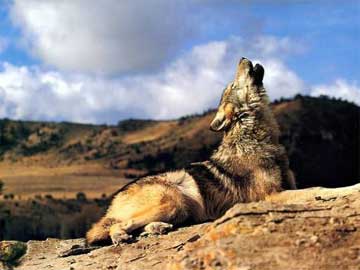

Wolves howl as a form of long-distance communication, conveying a range of information. Because of the high pitch and the suspension of notes, the sounds of wolf howls can carry as far as 6 miles (9.6 kilometers) in the forest and even 10 miles (16 kilometers) across the treeless tundra. (http://animals.howstuffworks.com/mammals/wolves-howling-at-moon1.htm)
A wolf's howl is as unique to that wolf as fingerprints are to a human. (http://www.wolfsource.org/?page_id=70) Wolves howl to try and regroup the pack, to signify the beginning of a hunt and also to communicate to other packs about their territory.
A howl starts off low until the wolf points its' nose to the sky and the tone gets higher. When one wolf starts howling another will join in in a different pitch. This is a clever adaptation because the wolves howling in different pitches makes it sound like the pack is much bigger. (http://www.wildernessclassroom.com/www/schoolhouse/boreal_
library/animals/wolf.htm)
